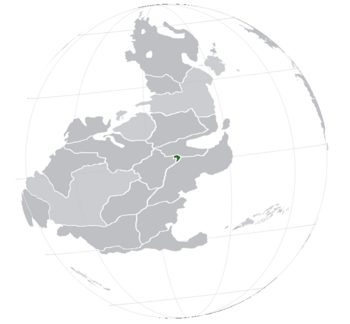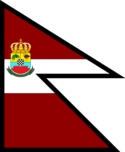Kwazulu-Ciskei
Kwazulu-Ciskei Empire | |
|---|---|
 | |
| Capital | Gcuwa (Imperial and Ciskei) Nongoma (Kwazulu) |
| Official languages | Zulu Xhosa |
| Recognised regional languages | Khoekhoe |
| Ethnic groups | |
| Demonym(s) | Kwazulu-Ciskeian |
| Government | Federal parliamentary constitutional dual monarchy |
• Emperor | Mpande kaSenzangakhona |
• Prime Minister of Kwazulu | Sibusiso Bengu |
• Prime Minister of Ciskei | Malashe ka Khawuta |
| Legislature | 2 national legislatures |
| Area | |
• Total | 20,868 km2 (8,057 sq mi) |
| Population | |
• 2022 estimate | 7,863,393 |
| GDP (nominal) | estimate |
• Total | 4,938,210,804 |
• Per capita | 628 |
| Currency | Izinkomo |
| Date format | dd/mm/yyyy, AC/ADc |
Kwazulu-Ciskei, offically the Kwazulu-Ciskei Empire (Zulu: Kwazulu-Ciskei Umbuso, Xhosa: Kwazulu-Ciskei Ubukhosiis) a constitutional dual monarchy and a multinational landlocked military and diplomatic alliance of two sovereign states, with a single monarch who is titled both Emperor of Kwazulu and Ciskei in central Ecros. It is bordered by TBD to the north, TBD to the west and Majocco to the south. It is the second most poorest country in the world and has the lowest GDP per capita in the world and is one of the least developed countries, facing widespread poverty, corruption, instability, authoritarianism, and illiteracy. Its total population, according to the 2022 census, is 7,863,393. It's imperial capital and largest city is Gcuwa with over 1 million population and so is the capital of Ciskei, Nongoma is the capital of Kwazulu.
First people likely appeared in the area making up the nearby areas and modern Kwazulu-Ciskei around 4th millennium BC. Kwazulu-Ciskei is one of the oldest countries on Ecros, tracing its heritage back to the 2nd millennium BC. Ancient Kwazulu-Ciskei is home to one of the ancient empires on the continent, known as the Zulu Empire, created after the unifications of multiple clans, which maintained a unified civilization in the region for 900 years. After the collapse of the ancient empire, a verity of successor states rose up, splitted between opposing heirs, meanwhile long feuds from Caliphates from Majocco. By the Middle Ages the waring states joined a Confederal feudal elective monarchy in the region originating from Majocco, which engulfed multiple small states in the region. Eventually the region was taken over by the TBD in 17-- ensuring an absolutist rule over Ciskei and regional states. With the arrival of nationalism, which fuelled the Xhosa Revolution of 1842, which was defeated but was a changing point in the history of the country. Radical changes led to the Compromise of 1844, which led to the creation of the Kwazulu-Ciskei Empire. This didn't last long was the country got caught in a war against Majocco in 1858, which it lost, resulting large amounts of lands lost and lead to the country collapsing in two states. The country was recreated after the royal coup in 1947, After the Kei River War, which brought back the dual monarchy. The country caught in self in a war with Majocco in 1991 over land disputes, which still rages on.
Contents
Etymology
The name comes from the two largest ethnic groups. The name kwaZulu translates roughly as Place of Zulus, or more formally Zululand. The name Ciskei means “on this side of the Kei river,” and is in contrast to the Eastern region, referencing the Kei river, the biggest one in the country, which splits Kwazulu and Ciskei and acts as the border between the two.
History
Pre-Historic Era
The area is home to one of the oldest human presence in Terraconserva. Archaeological excavations have demonstrated the presence early-human species likely originating from Majocco at several areas in oasis and river coasts. One of the oldest dated to about 390,000 years ago.
Early History
The switch from hunter-gatherers to agriculture civilisation occurred at the river regions in the middle of the country, where most of the arable land was located, surrounded by deserts . It quickly switched to major clans and it become one of the earliest River valley civilizations in the world. It become a trade hub with lots of cultures mixing.
TBD
Tarqiqini Lakes War
1858-1862
The division
Communism in Ciskei
After the collapse of the monarchy in 1873, the First Republic of Ciskei was established by scholars striving for democracy in the region, however Communism spread like a wildfire. The Communist party won the election of 1921, as a result they took over the country.
TBD
The reunification
1946-1991
Geography
At 124,842 km2, Kwazulu-Ciskei is the world's forty-six largest country after Tirol. Apart from the river region, the terrain is predominantly cold desert plains and sand dunes and hilly, mountainous regions in the north, where the most important river comes from, the Kei river and the Gcuwa river, which flows in to it.
Climate
Biodiversity
Politics
Government
Overview
In the sense of public law, it consists of two independent states, Kwazulu and Ciskei. After the Revolution of 1844, a compromise was made, which turned the Hlangene's domains into a real union between the lands of Kwazulu in the west and Ciskei and in the east. The two halves share a common monarch, who rules as the Emperor of Kwazulu and Ciskei, in the Kwazulu-Ciskeian Monarchy, the supreme power is concentrated in the hands of the common ruler, the emperor. Compared to the Ecrosian conditions, the powers of the Kwazuluian and Ciskeian ruler is extremely broad and strong, the emperor is the highest authority in the monarchy. Foreign relations and defense are managed jointly, and the two countries also formed a customs union. All other state functions is to be handled separately by each of the two states. Each parliament had its own executive government, appointed by the monarch. In this sense, Kwazulu-Ciskei remained under an autocratic government, as the Emperor appoints both Kwazulu and Ciskeian prime ministers along with their respective cabinets. Both sides maintain a separate parliament, where both government structures remain well separated and untouched, each with its own prime minister. There are three parts to the rule of the Kwazulu-Ciskei Empire:
- the common foreign, military, and a joint financial policy (only for diplomatic, military, and naval expenditures) under the monarch
- the "Kwazulu" government
- the "Ciskei" government
Parliaments
Both parliaments uses the Bicameral system. The Imperial Council hosts the legislature of Kwazulu, the House of Lords, House of Deputies located in Nongoma, the second largest city in the entire empire. The legislature of Ciskei is known as the Diet of Ciskei, which hosts the House of Magnates and the House of Representatives, located in Gcuwa.
Role of religion
Law and judicial system
Foreign relations
The Imperial and Royal Foreign Ministry is in charge of foreign relations, which is one of the three common ministries established in the Compromise, together with the Ministry of War and Joint Ministry of Finance concerned for the common aspects of the dual monarchy, i.e. the foreign policy, the Kwazulu-Ciskeian Army and the Air Force. The Minister of the Imperial and Royal House and of Foreign Affairs is nominated by the Emperor; he is also chairman of the Ministers' Council for Common Affairs as governing body of the Kwazulu-Ciskeian real union. The headquarters of the ministry is located in Gcuwa.
Also to note there is no common citizenship: one is either an Kwazuluian citizen or a Ciskeian citizen, never both. This also means that there is always separate Kwazuluian or Ciskeian passports, never a common one.
Military
The military force is compromised out of the Kwazulu-Ciskeian Army, Air Force and a river fleet. The Army is further devided in to the Royal Common Army, Royal Zulu Guards and the Royal Ciskei Army, which were separate national institutions. As stated above, the common army stood under the administration of the joint minister of war, while the special armies were under the administration of the respective ministries of national defence.
Administrative divisions
Other than a common military some aspects of government, the monarchy doesnt have its own administrative divisons. The two countries administrate their own divisons seperatly from each other, the other country has no control over states in the other. KwaZulu is devided in to 5 states and Ciskei is in to 4, in total 9 states, which all were created after the Compromise of 1***. Each state holds governmental juristiction over a specific territory of Kwazulu-Ciskei where it shares sovereignty with the local country, where its located.
Economy
Currency
Transport
Kwazulu-Ciskei's transport network is limited but developing. Several highways has been built and has a country wide rail network that connects both nations in the monarchy. There has been movement to further connect the countries with united services but progress has been slow, with only one unified bus company but there is still more country specific and mostly private transportation companies. The country has two fully paved international airports. The biggest one is the Nkayishana Maphumzana 'Phumuzuzulu' Solomon kaDinuzulu International Airport in Kwazulu. Gcuwa enjoys a light metro, however some lines are abandoned.
Demographics
Largest regions
Languages
The three most common languages are Zulu, Xhosa and Khoekhoe, in order of first language speakers. The first two are official languages of the monarchy and Khoekhoe is a recognised regional language but Zulu is most widely used in business, politics and education and is spoken by the vast majority of the population with 53% speaking Zulu fluently.
Religion
Education
Healthcare
Due to rampant corruption, the country has one of the most poorest hospital conditions and has limited access to medication and hospital equipment. The life expectancy in Kwazulu-Ciskei, as of 2014, was 61.8 years. The country has the worst hunger and malnourishment rates of all countries ranked. The healthcare system itself is divided in its respective domains of Kwazulu and Ciskei. Hospitals with quality care are mostly private institutions, which most are unable to pay for. The government funded hospitals lack equipment and staff to operate. The best quality healthcare is located in Ciskei, which has done reforms to fix the problem at hand. However the lack of doctors has effected the population. Most rural inhabitants only have access to healthcare in cities, which may be too far from them.




